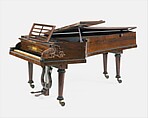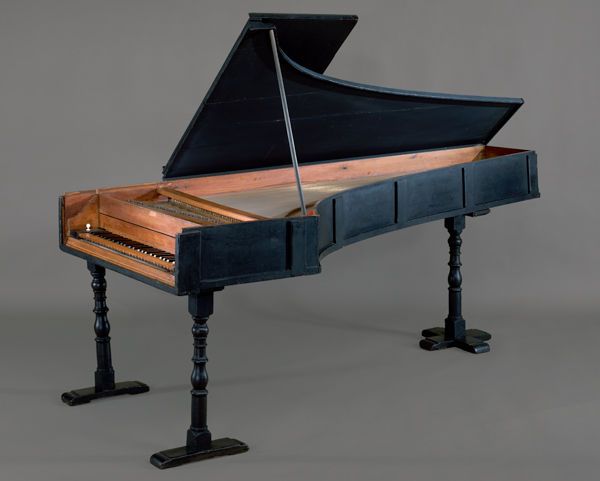Grand Piano
Not on view
John Broadwood (1732-1812) began his professional life as a cabinetmaker. In 1761 he went to London and worked with the well-established harpsichord maker Burkat Shudi. After marrying Shudi's daughter in 1769, he became a partner in the firm, and eventually manager nine years after his father-in-law's death in 1773. In the 1760s, Broadwood collaborated with other English makers to develop a grand piano action. The English action was more closely based on Bartolomeo Cristofori's design than the German or Viennese actions of the period. Broadwood's had a deeper key dip and a touch quite similar to the modern piano action, which is derived from it.
The cast iron frame, invented in America a few years before this piano was made, was not immediately accepted by British and Continental makers. A few, however, like Broadwood and Erard, bolted metal bars to the frame to improve tuning stability. The piano has three iron reinforcement bars bolted from pinblock to the bent side of the case as well as metal reinforcement below the soundboard.
Broadwood became the most important piano maker in England, and the firm produced approximately 1500 pianos a year in the 1820s. In 1818, Broadwood presented a piano to Beethoven, and this instrument remained one of the composer's most cherished possessions.
This piano has two pedals raise the dampers and provide an "una corda" shift. By adjusting a slide on the right key block, the "una corda" pedal can shift the action incrementally so that the hammers strike either one or two strings, rather than three.
Technical description: Case of rosewood veneer over oak with running, carved egg and dart molding on edge of lid and lower part of case, 3 metal braces running from wrestplank to hitchpin rail; six metal spacers between wrestplank and belly rail, exterior cheek brackets with double volute and foliate designs (brackets not original, left bracket missing); 4 round tapered legs veneered with rosewood, with turned and reeded capitals and bases; casters; lyre-shaped rosewood pedal lyre; compass CC-f4 (78 keys) ivory naturals with molded keyfronts, ebony accidentals, 2 wood pedals left shifting action to the right, right lifting dampers; oak pinblock veneered with curly maple, split bridge of beech, pierced square-head tuning pins; nameplate surrounded with brass inlay; English grand action with single escapement, backcheck, no intermediate lever; escapement regulated by oblong-head screws accessible behind nameboard; hammers covered with leather layers with new wound with copper over steel. (L. Libin, 8 Oct 76.)
#Sonata I in D Major by Alexander Reinagle. Performed by Jack Winerock for the album "Alexander Reinagle - Three Keyboard Sonatas," 1972. MHS 3359.
This image cannot be enlarged, viewed at full screen, or downloaded.



